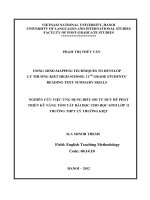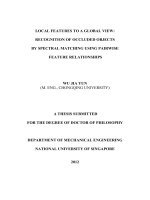AN0576 techniques to disable global interrupts
Bạn đang xem bản rút gọn của tài liệu. Xem và tải ngay bản đầy đủ của tài liệu tại đây (54.9 KB, 6 trang )
AN576
Techniques to Disable Global Interrupts
Author:
Mark Palmer
Microchip Technology Inc.
Contributions by Martin Burghardt
Manager Applications (Central Europe)
INTRODUCTION
This application note discusses four methods for
disabling global interrupts. The method best suited for
the application may then be used. All discussion will be
specific to the PIC16CXXX family of products, but
these concepts are also applicable to the PIC17C42,
and are shown in the even numbered examples. Note
that the PIC17C42’s global interrupt bit is called
GLINTD and has an inverse sense compared to the
GIE bit of the PIC16CXXX family.
To disable all interrupts, either the Global Interrupt
Enable (GIE) bit must be cleared or all the individual
interrupt enable bits must be cleared. An issue arises
when an instruction clears the GIE bit and an interrupt
occurs "simultaneously". For example, when a program
executes the instruction BCF INTCON, GIE (at
address PC), there is a possibility that an interrupt will
occur during this instruction. If an interrupt occurs dur-
EXAMPLE 1:
LOOP
BCF
BTFSC
GOTO
:
:
BSF
EXAMPLE 2:
LOOP
:
BSF
BTFSS
GOTO
:
:
BCF
ing this instruction, the program would complete execution of this instruction, and then immediately branch to
the user’s interrupt service routine. This occurs
because the GIE bit was not clear (disabled) when the
interrupt occurred. Normally at the end of the interrupt
service routine is the RETFIE instruction. This instruction causes the program to return to the instruction at
PC + 1, but also sets the GIE bit (enabled). Therefore
the GIE bit is not cleared as expected, and unintended
program execution may occur.
One method to ensure that the GIE bit is cleared is
shown in Example 1 and Example 2, as well as in the
PIC16CXXX data sheets. This method tests the state
of the GIE bit, after clearing, to ensure that it was not
accidentally set in the user’s interrupt service routine by
the RETFIE instruction. If the GIE bit was accidentally
set, the program branches back to the instruction that
clears the GIE bit.
In this method, the time to ensure that the GIE bit is
cleared is indeterminate. Depending on the frequency
of the enabled interrupts during this code segment,
unexpected delays into the following code segment
may occur. For some applications, this may be
undesirable. The following three methods address this
issue.
CLEARING THE GIE BIT (DISABLING INTERRUPTS, METHOD 1, PIC16CXXX)
INTCON, GIE
INTCON, GIE
LOOP
;
;
;
;
Disable Global Interrupt
Global Interrupt Disabled?
NO, try again
YES, continue with program flow
INTCON, GIE
; Re-enable Global Interrupt
SETTING THE GLINTD BIT (DISABLING INTERRUPTS, METHOD 1, PIC17C42)
CPUSTA, GLINTD ; Disable Global Interrupt
CPUSTA, GLINTD ; Global Interrupt Disabled?
LOOP
; NO, try again
; YES, continue with program flow
CPUSTA, GLINTD ; Re-enable Global Interrupt
1997 Microchip Technology Inc.
DS00576B-page 5-99
AN576
The second method is to disable the individual interrupt
enable bits. If it is known which bits are enabled at this
point, it can easily be done. Example 3 and Example 4
show the disabling of interrupts, where it is known
which sources are enabled (some peripheral interrupts
and the T0CKI pin interrupt).
EXAMPLE 3:
:
MOVLW
ANDWF
:
:
:
MOVLW
IORWF
:
CLEARING KNOWN INDIVIDUAL INTERRUPT ENABLE BITS
(METHOD 2, PIC16CXXX)
b’10011111’
INTCON, F
; Disable Peripheral and T0CKI pin interrupts,
; All other bits unchanged
b’01100000’
INTCON, F
; Re-enable Peripheral and T0CKI pin interrupts,
; All other bits unchanged
EXAMPLE 4:
:
MOVLW
ANDWF
:
:
:
MOVLW
IORWF
:
This method also requires the same number of
instructions for the disabling/enabling of interrupts, as
method 1, but requires a knowledge of which individual
interrupt enable bits need to be disabled and (more
importantly) re-enabled. The major advantage of this
method is that it can minimize the time delay entering
the code segment which follows the point where
interrupts are disabled.
CLEARING KNOWN INDIVIDUAL INTERRUPT ENABLE BITS
(METHOD 2, PIC17C42)
b’11110011’
INTSTA, F
; Disable Peripheral and T0CKI pin interrupts,
; All other bits unchanged
b’00001100’
INTSTA, F
; Re-enable Peripheral and T0CKI pin interrupts,
; All other bits unchanged
DS00576B-page 5-100
1997 Microchip Technology Inc.
AN576
Method 3 can be used if the states of the individual
interrupt enable bits are unknown. A temporary byte of
data RAM is required to store the value of the INTCON
register. This method is shown in Example 5 and
Example 6.
EXAMPLE 5:
This method also requires more instructions for the
disabling/enabling of interrupts than in method 1 or
method 2, and also a byte of data RAM to temporarily
store the value of the INTCON register. The major
advantage of this method is that it minimizes the time
delay into the code segment which follows the point
where interrupts are disabled.
CLEARING THE INDIVIDUAL INTERRUPT ENABLE BITS (METHOD 3, PIC16CXXX)
:
MOVF
MOVWF
MOVLW
ANDWF
:
:
:
MOVF
IORWF
:
INTCON, W
S_INTCON
b’10000111’
INTCON, F
;
;
;
;
S_INTCON, W
INTCON, F
; Restore the INTCON register
;
EXAMPLE 6:
:
MOVPF
MOVLW
ANDWF
:
:
:
MOVFP
IORWF
:
Move the value in INTCON to
a shadow register
Disable all individual interrupts,
All other bits unchanged
CLEARING THE INDIVIDUAL INTERRUPT ENABLE BITS (METHOD 3, PIC17C42)
INTSTA, S_INTSTA
b’11110000’
INTSTA, F
; Move the value in INTSTA to a shadow register
; Disable all individual interrupts,
; All other bits unchanged
S_INTSTA, W
INTSTA, F
; Restore the INTSTA register
;
1997 Microchip Technology Inc.
DS00576B-page 5-101
AN576
The final method is to use a RAM location to “shadow”
the value of the GIE bit. This shadow bit can then be
used in the interrupt service routine to determine which
return instruction to use. That is, either the RETURN or
the RETFIE (which enables the GIE bit) instruction.
Example 7 and Example 8 show this implementation,
which require that a general purpose bit be available to
hold the “shadow“ GIE value. In these examples, the
shadow GIE (S_GIE) bit is contained in the register
FLAG_REG. If an interrupt occurs during the clearing
of the shadow GIE, the interrupt is responded to. At the
end of the interrupt service routine, the shadow GIE bit
is cleared so the RETURN instruction is executed. The
GIE bit remains disabled and program execution
returns to the instruction which tries to clear the GIE bit
EXAMPLE 7:
(disable). No interrupts can occur during this instruction
since the GIE bit was not re-enabled after the interrupt
service routine.
This method also requires more instructions for the
disabling/enabling of interrupts than in method 1 or
method 2, and a single bit of data RAM to temporarily
store the value of the desired GIE value, and increases
the interrupt service routine execution time by one
instruction cycle, for most occurrences of interrupts
(two cycles worst case). The major advantage of this
method is that it minimizes the time delay into the code
segment which follows the point where interrupts are
disabled. Also, the individual interrupt enable bits need
not be modified.
THE “SHADOW” GIE BIT (METHOD 4, PIC16CXXX)
:
org
0x004
INT_SERVICE_ROUTINE
:
:
BTFSC
FLAG_REG, S_GIE
RETFIE
RETURN
END_INT_SERVICE_ROUTINE
;
MAIN:
:
:
BCF
FLAG_REG, S_GIE
BCF
INTCON, GIE
:
:
:
BSF
FLAG_REG, S_GIE
BSF
INTCON, GIE
:
:
END
EXAMPLE 8:
; Is the S_GIE bit enabled?
; YES, the GIE should be enabled
; NO, the GIE should be disabled
; Clear the shadow GIE bit
; Disable interrupts by clearing the GIE bit
; Set the shadow GIE bit
; Enable interrupts by setting the GIE bit
THE “SHADOW” GLINTD BIT (METHOD 4, PIC17C42)
:
org
0x004
INT_SERVICE_ROUTINE
:
:
BTFSS
FLAG_REG, S_GLINTD
RETFIE
RETURN
END_INT_SERVICE_ROUTINE
;
MAIN:
:
:
BSF
FLAG_REG, S_GLINTD
BSF
CPUSTA, GLINTD
:
:
:
BCF
FLAG_REG, S_GLINTD
BCF
CPUSTA, GLINTD
:
:
END
DS00576B-page 5-102
; Is the S_GLINTD bit enabled?
; YES, the GLINTD should be enabled
; NO, the GLINTD should be disabled
; Set the shadow GLINTD bit
; Disable interrupts by setting the GLINTD bit
; Clear the shadow GLINTD bit
; Enable interrupts by clearing the GLINTD bit
1997 Microchip Technology Inc.
AN576
CONCLUSION
In conclusion, different methods exist to ensure that all
interrupts are disabled. The requirement(s) of the
application determines which of the methods is the best
fit. A comparison of the different methods is shown in
Table 1.
TABLE 1:
COMPARISON OF DIFFERENT METHODS
Cycle Delay (TCY)
Program Memory
Data Memory
Best Case
Worst Case
Method 1
2 words * N
2
Indeterminate
Method 2
2 words * N
1
1 + TISR
Method 3 - PIC16CXXX
4 words * N
1 byte
3
3 + TISR
3 words * N
1 byte
2
2 + TISR
2 words * N + 2 words
1 bit
1†
1 + (TISR + 2)
- PIC17C42
Method 4
Legend:
N
TISR †
Number of occurrences to disable / re-enable interrupts.
Time to execute the interrupt service routine.
This method increases the interrupt service routine time (TISR) by 1 cycle for most
occurrences (2 cycles worst case).
1997 Microchip Technology Inc.
DS00576B-page 5-103
AN576
NOTES:
DS00576B-page 5-104
1997 Microchip Technology Inc.









